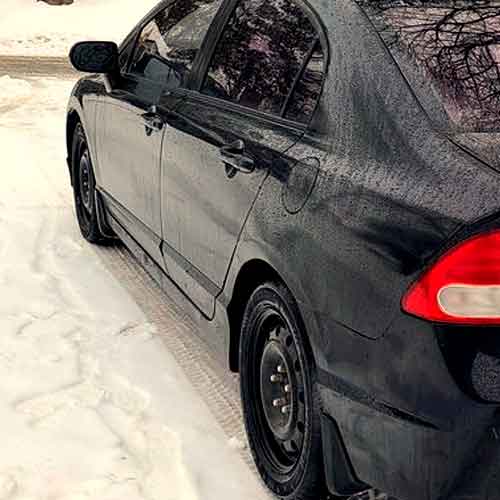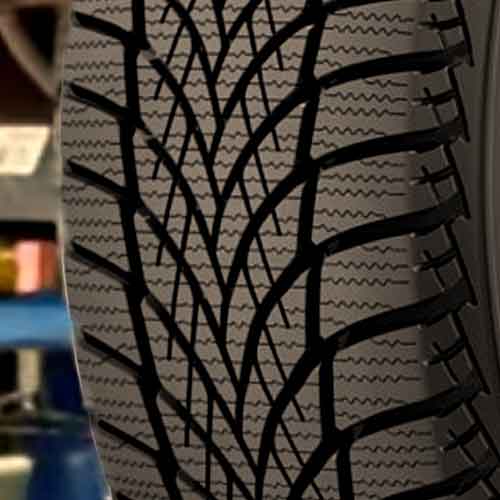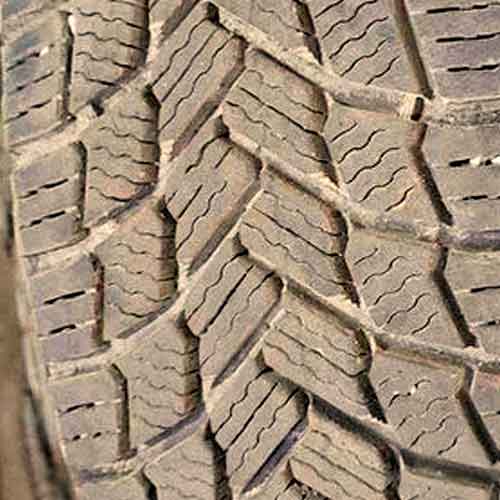Michelin X Ice Snow and Goodyear WinterCommand Ultra, both being highly rated winter tires, outshine in different segments, setting new paradigms in performance, energy efficiency, and ride tranquility, providing an array of alternatives to suit different user choices and driving scenarios.

Table of Contents
Available Sizes
The Michelin X-Ice Snow (review) comes in 125 total sizes in 15 to 22 inches. They have following specs.
- Speed ratings: T and H.
- Load ratings: SL and XL.
- Tread depth: 10.5/32″ on all.
- Weight: 16 to 40 lbs.
- Tread warranty: 40k miles.
On the other side, the Goodyear WinterCommand Ultra (review) comes in 15 to 18 inches with following.
- Speed ratings: H only.
- Load ratings: SL and XL.
- Tread depth: 11/32″ on all.
- Weight: 18 to 28 lbs.
- Tread warranty: None.
Tread Pattern
Starting with the Goodyear WinterCommand Ultra, the tire is characterized by a three-rib design.

At the center, the lugs may seem divided due to the presence of in-groove notches, as these incisions do not penetrate their full depth.
These lugs integrate smoothly with the adjacent blocks, creating a distinctive V-shaped pattern.
These blocks are further enhanced with an abundance of laterally positioned, interlocking sipes.
Moreover, the presence of numerous in-groove biters is evident, with the lugs separated by sinuous lateral grooves as well as longitudinal channels that cut across the shoulders.
The shoulder blocks are notably the most substantial.
Despite their sharp chamfered edges, they maintain a siping pattern consistent with the central lugs.
Of particular interest are the unique T-shaped biters found at the outer edges, or the sidewalls, as they might be referred to.
Moving on towards the Michelin X Ice Snow, you see another directional tread design.

Its tread is formed by 6 total ribs.
The narrowest and hardest to negotiate groove is centrally located, created by two ribs featuring blocks with multiple keen edges, wavy sipes, and chamfered sides.
Smaller, similarly designed lugs encircle these central features but are spaced more generously.
All blocks interconnect on a secondary rubber layer, lending stability to the lugs as the tire navigates.
The shoulder blocks bear somewhat softer edges, a squared-off look, and sport lateral rectilinear sipes and notches on their outer boundaries.
And yes, they also get the thickest of all siping (of rectilinear design).
Snow Performance
When it comes to handling in snow, both tires perform well. However, the Goodyear tire does have a small advantage, as seen after considering all.
But why is this so?
Well, if you look at its design, you’ll see it has wider gaps and notches in its tread that catch and hold snow. This design feature is important because snow sticks better to snow than it does to rubber, helping the tire get a good grip.
Moreover, the this tire has a special V-shaped lug design that helps push snow away and drive the tire forward, allowing for slightly quicker acceleration.
On the other hand, the Michelin X-Ice Snow tire performs a little less well in these conditions due to its tread design, which includes a continuous center rib and narrower notches.
Winner: Goodyear WinterCommand Ultra
Ice Performance
When it comes to ice, however, the Michelin X-Ice Snow tire takes the lead. In tests, it consistently stopped 11 feet shorter than the Goodyear tire.
It also has a slight advantage in acceleration, being one second quicker in the 0-40 mph test.
This superior performance is due to the unique biting edges distributed across the tread and the dual-angled design which enhances grip on densely packed snow surfaces.
On the other hand, the Goodyear WinterCommand Ultra tire struggles a bit on ice because of its wider tread gaps and fewer biting edges.
Winner: Michelin X Ice Snow
Wet Traction
Traction on wet surfaces is heavily influenced by two key elements: the tread design and the type of rubber compound utilized. These factors affect the grip and resistance to hydroplaning, so let’s talk about them both.
Now when it comes to grip, both tires put up a strong fight in this department, thanks to their ample siping and use of soft tread rubbers.
However, the Michelin X-Ice Snow tire manages to carve out an edge.
This superiority is attributable to its clever mix of linear and interlocking sipes that are capable of absorbing water and providing an exceptional wet grip.
Furthermore, their multi-angled design bolsters cornering and braking abilities, especially when the sipes align with the direction of the tire’s motion.
In contrast, the Goodyear WinterCommand Ultra primarily employs laterally oriented sipes, which fall short in providing comparable overall traction.
Consequently, it often displays longer wet braking distances and handling times.
However, this tire does outperform in hydroplaning resistance, a key component of overall wet traction. Its V-shaped lugs excel in clearing water, enabling higher average float speeds in both straight and curved aquaplaning tests.
Winner: Both!
Dry Traction
Dry traction is dependent on the tire’s overall ground contact and can be split into two components: directional grip and lateral traction.
In both categories, the Michelin X-Ice Snow tire outperforms its Goodyear counterpart. Its continuous central rib ensures dependable and consistent road contact, resulting in shorter braking distances and quicker acceleration times during tests.
The Goodyear WinterCommand Ultra, however, makes a comeback when it comes to dry handling.
Even though both tires showcase similar shoulder footprints in contact with the road surface, the Goodyear tire makes the most of its rubber’s contact, delivering superior performance.
Winner: Michelin X Ice Snow.
Comfort Levels
Tire comfort is primarily determined by factors like road noise generation and vibration absorption capabilities.
These attributes can vary based on the tire’s construction, the materials used, the tread design, and the configuration of the sidewalls.
In this respect, both tires offer a remarkably similar performance.
They provide a supremely smooth ride and are impressively adept at cushioning against road bumps.
Moreover, both tires exhibit comparable noise reduction abilities, a critical factor since noise is mainly produced when the air particles collide with the tire’s tread walls.
Winner: Both!
Fuel Economy
Factors such as the tire’s adherence to the road surface and the overall tread pattern significantly influence fuel consumption. In light of these considerations, it’s evident that the Michelin X-Ice Snow tire delivers superior overall performance.
Its longitudinally aligned central rib translates to a more streamlined tread design, promoting better, straighter rolling of the tire. This design leads to decreased overall rolling resistance, thereby consuming less fuel.
On the other hand, the Goodyear WinterCommand Ultra’s directional tread pattern featuring lateral tread voids poses more challenges as the tire rolls.
This results in increased overall rolling resistance, leading to more fuel consumption.
Winner: Goodyear WinterCommand Ultra
Verdict?
Upon a thorough comparison of these two stellar winter tires, it’s clear that each brings unique strengths to the table.
The Goodyear tire excels in deep snow conditions, thanks to its wider tread voids and notches, as well as V-shaped lugs for unmatched snow displacement. Moreover, it exhibits impressive lateral traction on dry roads.
The Michelin X-Ice Snow, on the other hand, showcases superior traction capabilities on icy terrain, owing to its abundance of biting edges and varied incisions.
Additionally, it offers better braking and handling efficiency on wet roads and edges out slightly in terms of fuel economy.
In the domain of comfort, however, both tires are evenly matched, delivering equally outstanding performances.